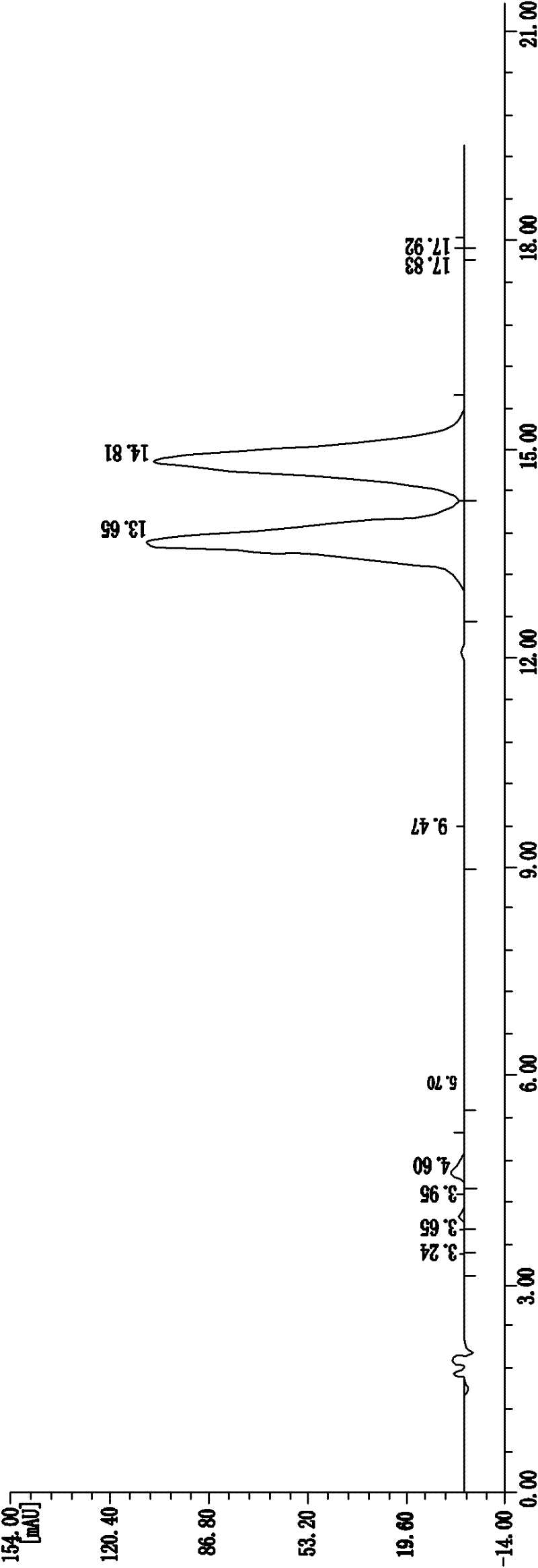Manufacturing method of proPiconazole
A production method and a technology for propiconazole, applied in the field of pesticides, can solve the problems of difficult dehydration, affect the refining yield, sticky materials, etc., and achieve the effects of reducing waste water discharge, reducing environmental pollution, and improving yield
- Summary
- Abstract
- Description
- Claims
- Application Information
AI Technical Summary
Problems solved by technology
Method used
Image
Examples
Embodiment 1
[0053] According to the ratio of the amount of the substance 2,4-dichloroacetophenone: 1,2-pentanediol: the catalyst phosphomolybdic acid ratio of 1:1.07:0.02, the 2,4-dichloroacetophenone and 1, 2-Pentanediol is refluxed under the action of the catalyst phosphomolybdic acid for the cyclization reaction. At this time, the temperature is 86°C and the reaction time is 8 hours. After the cyclization reaction is completed, the catalyst phosphomolybdic acid is filtered and recovered for bromination reaction. The bromination reaction temperature is 35°C, and the bromine drop acceleration rate is 18Kg / h. After the bromination reaction is over, keep 0.3Mpa and stir for 1h, recover hydrogen bromide gas, and remove the solvent to obtain 2-bromomethyl-(2, 4-Dichlorophenyl)-4-propyl-1,3-dioxpentane. In the present invention, the synthesized cyclized product is first recovered to remove the catalyst phosphomolybdic acid, and then the bromination reaction is carried out. The rate can reach m...
Embodiment 2
[0056] According to the ratio of the amount of 2,4-dichloroacetophenone:1,2-pentanediol:catalyst phosphomolybdic acid is 1:1.13:0.06, the 2,4-dichloroacetophenone and 1, 2-Pentanediol is refluxed under the action of the catalyst phosphomolybdic acid to carry out the cyclization reaction. At this time, the temperature is 83~88℃, and the reaction time is 8 hours. After the cyclization reaction is completed, the catalyst phosphomolybdic acid is filtered and recovered for bromination reaction. The bromination reaction temperature is 36°C, and the bromine drop acceleration rate is 19Kg / h. After the bromination reaction is over, keep 0.4Mpa and stir for 1.5h, recover the hydrogen bromide gas, and remove the solvent to obtain 2-bromomethyl- (2,4-Dichlorophenyl)-4-propyl-1,3-dioxpentane. In the present invention, the synthesized cyclized product is first recovered to remove the catalyst phosphomolybdic acid, and then the bromination reaction is carried out. The yield of bromide can rea...
Embodiment 3
[0059] According to the ratio of the amount of 2,4-dichloroacetophenone:1,2-pentanediol:catalyst phosphotungstic acid of 1:1.20:0.1, combine 2,4-dichloroacetophenone and 1, 2-Pentanediol is refluxed under the action of the catalyst phosphotungstic acid for the cyclization reaction. At this time, the temperature is 85~89℃, and the reaction time is 4~8 hours. After the cyclization reaction is completed, the catalyst phosphomolybdic acid is filtered and recovered for bromine The bromination reaction temperature is 37°C, and the bromine drop acceleration rate is 20Kg / h. After the bromination reaction is over, keep 0.5Mpa and stir for 2h, recover hydrogen bromide gas, and remove the solvent to obtain 2-bromomethyl -(2,4-Dichlorophenyl)-4-propyl-1,3-dioxpentane. In the present invention, the synthesized cyclized product is first recovered to remove the catalyst phosphomolybdic acid, and then the bromination reaction is performed , The bromide yield can reach more than 98%wt, and the ...
PUM
| Property | Measurement | Unit |
|---|---|---|
| refractive index | aaaaa | aaaaa |
Abstract
Description
Claims
Application Information
 Login to View More
Login to View More - R&D Engineer
- R&D Manager
- IP Professional
- Industry Leading Data Capabilities
- Powerful AI technology
- Patent DNA Extraction
Browse by: Latest US Patents, China's latest patents, Technical Efficacy Thesaurus, Application Domain, Technology Topic, Popular Technical Reports.
© 2024 PatSnap. All rights reserved.Legal|Privacy policy|Modern Slavery Act Transparency Statement|Sitemap|About US| Contact US: help@patsnap.com








